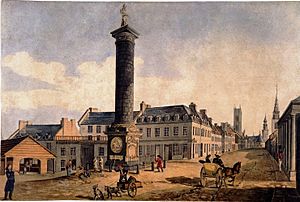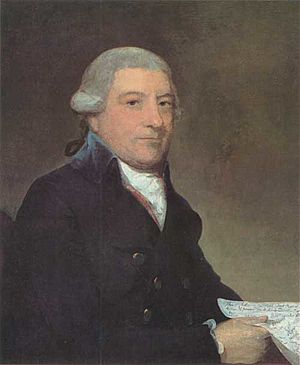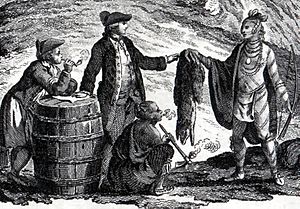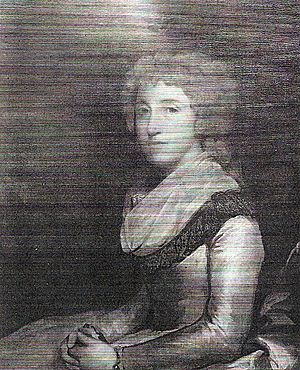Alexander Henry the elder facts for kids
Alexander Henry 'The Elder' (born August 1739 – died April 4, 1824) was a famous fur trader and explorer. He became a partner in the North West Company and helped start the Beaver Club.
He is well-known for living with Wawatam, a chief of the Ojibwe people, who adopted him as a brother. Henry wrote a book about his adventures called Travels and Adventures in Canada and the Indian Territories between the years 1760 and 1776. This book is a classic adventure story and gives a great look into Native American life during that time.
Henry was a great storyteller. In 1776, he was invited to share his journeys with the Royal Society in London and even with Queen Marie Antoinette at Versailles in France. Later, Henry helped John Jacob Astor get started in the Canadian fur trade.
Contents
Alexander Henry's Early Life and Adventures
Alexander Henry was born in New Brunswick, New Jersey. His family were merchants, and he got a good education. When he was twenty, Henry started working as a merchant in Albany, New York.
He made money by supplying the British army during the French and Indian War. In 1760, after a big battle, Henry helped move supplies to Montreal. He was one of the first Englishmen to visit the area of Milwaukee.
In 1761, Henry met Jean-Baptiste Leduc, who told him about the great opportunities in fur trading around Lake Superior. Henry got a special pass to trade furs from Major-General Thomas Gage. He bought many goods and set off for Fort Michilimackinac.
Since he was new to fur trading, Henry hired an experienced guide named Etienne-Charles Campion.
Adventures with the Ojibwe People
As Henry traveled west in 1761, Indians warned him about the Ojibwe people. They were still loyal to the French. Henry disguised himself as a simple traveler, but no one was fooled.
When he arrived at Michilimackinac, sixty Ojibwe warriors surrounded him. Their chief, Minweweh, told Henry that the English had not conquered the Ojibwe. Henry used his diplomatic skills, and Minweweh admired his bravery. He told Henry he could "sleep tranquilly" among them.
That winter, a kind Ojibwe chief named Wawatam adopted Henry as his brother. Henry described the Ojibwe as "peaceful," "kind," and "trustworthy." He had great respect for them.
Henry's ability to make friends with both the French and the Native Americans helped his trading. In 1762 and 1763, he traded at Sault Ste Marie. He became friends with Jean Baptiste Cadotte, Sr.
However, when they returned to Michilimackinac, Chief Pontiac had started an uprising against British forts. The Ojibwe warriors attacked Fort Michilimackinac. Henry was captured by the Ojibwe.
Fortunately, Wawatam saved Henry and hid him in Mackinac Island's Skull Cave. Henry lived with Wawatam and his family for almost a year. He learned about their hunting and fishing life in lower Michigan. His writings about this time are very important for understanding Native American life during the fur trade era.
In the spring of 1764, they returned to Michilimackinac. Some Ojibwe from Saginaw Bay wanted to kill Henry. Wawatam helped him go to Sault Ste Marie for protection. Cadotte helped keep him safe.
Soon after, Sir William Johnson, 1st Baronet held a peace conference at Fort Niagara. Both Henry and the Ojibwe attended. Henry then returned to Michilimackinac with British troops in September 1764.
Exploring the Canadian North West
In 1765, Henry got a license to trade in the Lake Superior area. He partnered with Cadot, combining British money with French Canadian experience. For a few years, Henry had a complete monopoly (meaning he was the only one) over the Lake Superior trade. This allowed him to charge high prices.
He also met the frontiersman Robert Rogers there. In 1767–68, Henry formed a company with Sir William Johnson, 1st Baronet and others to mine silver and copper ore near Lake Superior. However, this project cost too much money and ended in 1774.
In 1775, Henry took many canoes to explore the land northwest of Lake Superior. Henry, Cadot, Peter Pond, and the Frobisher brothers began to challenge the Hudson's Bay Company. Their group built a trading post on Amisk Lake. This was the first post built north of the Saskatchewan River.
In 1776, Henry traveled by foot to Fort de la Corne. He followed the Saskatchewan River and traded furs with the Assiniboine people. He also bought many beaver skins from the Chipewyan people. Henry returned to Montreal with many furs and gave Governor Sir Guy Carleton a large map of the western region he had explored.
Journeys to England and France
Henry was very interested in the rich possibilities of the Northwest Territories. In 1776, he sailed to England with a plan for the Hudson's Bay Company. He then went to France and was welcomed warmly.
Through a friend, Henry was even received by Queen Marie Antoinette at the French Court. However, Henry was disappointed by her and her court's condescending attitude.
Henry returned to British North America in 1777 and continued trading. Between 1778 and 1781, he visited England three more times. He became friends with Sir Joseph Banks and Daniel Solander. On his last trip, Henry gave Banks a detailed plan for an expedition to find an overland route to the Pacific Ocean. This plan didn't work out due to new information about Captain Cook's findings.
Life in Montreal and New Ventures
Henry became well-known, and from 1781, he settled in Montreal as a general merchant. He still loved the fur trade and made trips to Detroit or Michilimackinac. In 1785, Henry was a founding member of the Beaver Club in Montreal.
In the mid-1780s, Henry encouraged his friend William Edgar to trade furs with China. Henry shared his ideas about the Pacific coast with John Jacob Astor. He introduced Astor to the Canadian trade, and Astor stayed with Henry during his visits to Montreal. In the 1790s, Henry and Astor helped Simon McTavish and the North West Company send furs to China.
During the 1790s, Henry and his friend John Askin were interested in buying land in Ohio. One of their plans, called the Cuyahoga Purchase, failed. The Native American tribes who had sold the land refused to confirm the sale. This caused Henry to lose a lot of money.
Later Years and Legacy

In 1792, Henry and his nephew Alexander Henry the younger bought a share in the North West Company. He later sold his share but continued to buy and export furs. In 1801, he lost a lot of money when one of his shipments was captured by the French.
To recover his money, Henry became a commission merchant and auctioneer. He worked hard, even though he was often sick and didn't enjoy the job.
Despite these challenges, Henry remained an important part of Montreal's business society. He was a captain in the militia and a justice of the peace for many years. He hosted important merchants and was very active in the Beaver Club, where he was a senior member and vice-chairman. In 1806, he helped fund the building of Nelson's Column, Montreal.
In 1809, Henry wrote his life story, Travels and Adventures in Canada and the Indian Territories, between the years 1760 and 1776. He dedicated it to his friend Sir Joseph Banks. This book is still considered a Canadian adventure classic and one of the best descriptions of Native American life during his travels.
Henry was known as "the handsome Englishman" by Native Americans and the French. He never regained all the wealth he had, but he is remembered for his achievements in society. He was one of the most important business leaders who helped make Montreal a center for trade. Alexander Henry died at his home in Montreal at age 85, respected by everyone who knew him.
Alexander Henry's Family Life
Like many early fur traders, Henry had a "country wife," a Native American woman. They had at least one daughter. In 1785, after returning to Montreal society, he married Julia Calcutt Kittson (1756–1835). She was a strong woman from Limavady and a widow.
Julia and Alexander had several children, some born before they married. Henry was also a step-father to Julia's two children from her first marriage.
- Martha Henry (1777–1849): She was Henry's daughter from his country wife. She married William Hallowell, who bought Henry's share in the North West Company.
- Mary Kittson: Henry's stepdaughter.
- George Kittson (1779–1832): Henry's stepson. He had several children, including Norman Kittson.
- Julia Henry (born 1780): She never married.
- William Henry (1784–1864): He was a fur trader and later a surveyor and civil engineer in Montreal. He had many adventures, including being attacked by a Grizzly bear in the Rocky Mountains. He joined the Beaver Club in 1817.
- Alexander Henry (1785–1812): Not to be confused with his cousin. He also worked for the North West Company but was sadly killed by Native Indians near Port Nelson, Manitoba.
- Robert Henry (born after 1785): He was a partner in the North West Company. He joined the Beaver Club in 1815.
- John Henry (1786–1787): He died as a baby.
Images for kids
-
Nelson's Column, Montreal. Erected in 1809, Henry was one of the principal donators.










